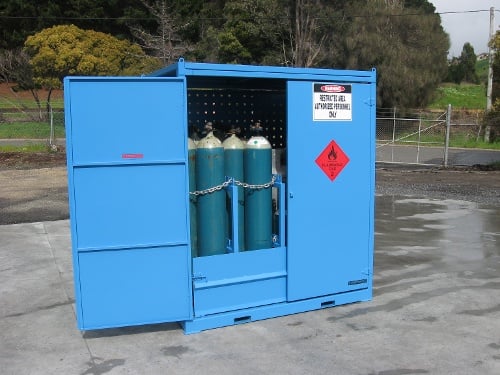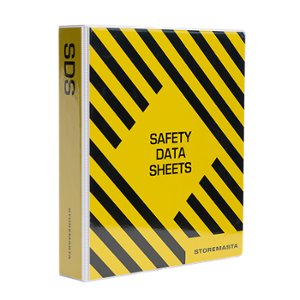If you use any hazardous chemicals at your worksite, you’re responsible for ensuring they are stored safely in a way that complies with the current work health and safety (WHS) laws in your state or territory. This post highlights some of the key chemical safety best practices, so you can learn how to store hazardous chemicals legally and safely in your own workplace.
But remember — you can’t store any substance safely unless you identify the chemical and understand its properties and hazards.
Identify Each Hazardous Chemical
Correctly identifying a chemical is just about the most important part of your chemical management program. Get started by requesting the safety data sheet (SDS) from the manufacturer or supplier and read it carefully.
The SDS will indicate the:
- Correct name of the chemical (liquid chlorine)
- Hazard class (corrosive)
- Health hazards (causes severe skin burns and eye damage, do not breathe vapours)
- Handling requirements (use only outdoors or in a well-ventilated area)
- Storage requirements (store locked up, keep containers closed when not in use, protect from heat, store away from incompatible materials)
- PPE to use when handling (safety glasses with top and side shields or goggles)
- First aid measures (if swallowed do not induce vomiting, wash mouth with water)
- Emergency procedures (use water spray to cool fire-exposed containers, wear Safe Work Australia approved self-contained breathing apparatus and full protective clothing)
- Environmental hazards (very toxic to aquatic organisms)
REMEMBER: Only use the safety data sheet provided by the manufacturer or supplier. Generic SDSs don’t allow for manufacturing variations that may introduce new or different chemical hazards.
Understand The Risks They Present
Once you have carefully reviewed the SDS, you can start to understand the risks associated with that chemical product. From the example above you can see that a hazardous chemical like liquid chlorine has a number of different hazards. Most chemicals do. Each will contribute to your decision about how it will be stored.
Your chemicals may have multiple risks that need to be controlled.
From the information provided in the safety data sheet, you can take into consideration: what type of firefighting equipment you might need nearby, where the chemicals can be stored (maybe it’s outside); if they must be locked in a safety cabinet, and any incompatible substances that might cause a dangerous chemical reaction if located too close.
Segregate Incompatible Hazardous Chemicals
The SDS will list any incompatible materials that could cause a dangerous reaction if the chemicals are mixed together.
Reactions like:
- Fire
- Explosion
- Heat
- Pressure
- Poisonous dusts, fumes, and gases
Your risk management and control measures will need to address each incompatible substance that is either used or manufactured onsite and what dangerous reactions could occur.
Some of the ways to keep incompatible substances segregated is by creating a safe distance between chemicals or partitioning the workplace.
Another simple and cost-effective option is providing separate chemical safety cabinets (or outdoor storage containers) which are specifically constructed for each particular dangerous goods class.
TIP: Do not assume that different corrosive substances can be safely stored together. To learn more about chemical segregation, download your FREE segregation chart.
Keep Hazardous Chemicals Compliant Storage
When selecting chemical storage equipment, it’s essential that you choose stores that are designed and constructed to meet the many requirements of the Australian Standards. Without compliant storage, your workplace may be at risk of health and physicochemical hazards, as well as non-compliance with the WHS laws in your state or territory.
Indoor chemical storage and outdoor chemical storage have different construction requirements which allows the storage equipment to be suitable for the environment.
Both indoor chemical storage cabinets and outdoor chemical storage containers offer a range of features to control the risks associated with the hazardous chemicals being stored. These include lockable doors to prevent unauthorised entry, spill containment and chemical segregation from other incompatible substances kept at the worksite.
However, there are further features which distinguish indoor cabinets from outdoor stores, such as natural ventilation and cyclone protection for outdoor stores. On the other hand, indoor safety cabinets are fitted with self-closing, tight-fitting doors to provide vapour containment, as well as a thermal air barrier to protect the contents from fire and excessive heat.
REMEMBER: The Australian Standards outline different requirements for indoor storage and outdoor storage of dangerous goods. Indoor storage solutions include compliant safety cabinets and outdoor storage solutions normally comprise of chemical storage containers that have been manufactured in full conformance to the relevant Australian Standard.
Isolate Ignition Sources
If your workplace stores flammable chemicals, gas cylinders or any other types of chemicals that require protection from heat and ignition sources, there are many safety measures that you have to implement.
You’ll need to control all potential ignition sources and conduct a full risk assessment for each substance that could be affected by heat or an ignition source.
Look at any ways the storage area might be exposed to:
- Heat
- Sunlight
- Static electricity
- Lightning
- Machinery
- Work processes that generate sparks
- Electronics like mobile phones, computers and tablets
REMEMBER: Conducting a full risk assessment on the hazards that surround each and every hazardous chemical stored at your workplace is essential for WHS compliance in Australia.
Maintain a Register of Hazardous Chemicals
All organisations must keep a register of hazardous chemicals that are used onsite. This register must include a list of all the product names of the hazardous chemicals that are used onsite, as well as the safety data sheets that accompany the hazardous chemicals. This register must be updated when new chemicals are introduced into the workplace and when the use of certain hazardous chemicals are discontinued.
This register of hazardous chemicals must be available to all workers that are involved in using, handling and storing hazardous chemicals. Your workers require a register of hazardous chemicals to safely store and handle each of the hazardous products that you have in your workplace.
Provide Access to Current Safety Data Sheets
To ensure that all workers are aware of the risks associated with the hazardous chemicals used in your organisation, it’s very important to provide all your workers with access to the safety data sheet associated with each hazardous chemical.
Safety data sheets are documents that outline the specific fire, reactivity, environmental and health hazards associated with a particular hazardous chemical. Safety data sheets also outline the specific storage and handling requirements for the particular hazardous chemical. Before an unfamiliar hazardous substance is used, handled or stored the safety data sheet for that particular substance must be consulted to ensure that it’s being stored and handled in the safest manner.
To ensure that your workers have got easy access to safety data sheets, they must be kept in a document storage box close to the area where the hazardous substance is being stored. This also allows the safety data sheets to be easily accessed in the event of an emergency.
Safety data sheets must be kept up-to-date, so that all properties and hazards of the chemical are correct.
Clearly Label All Hazardous Chemical Storage Facilities and Packages
To ensure that workers and visitors are aware of the potential risks associated with the hazardous chemicals that are stored onsite, it’s important to clearly label all hazardous chemical storage facilities with the correct warning and dangerous goods signage.
All dangerous substances pose different risks upon people and signage is a method that can be used to clearly distinguish the specific hazards associated with the substances being stored. Some of the different hazards associated with dangerous substances include; fire, explosion, toxicity, corrosivity, oxidising and spontaneous combustion.
TIP: Compliant safety cabinets and outdoor chemical storage containers will have the mandatory placards and labels in place for that particular hazard class. However, if your chemical has a subrisk, make sure that the store is further placarded with dangerous goods signage and hazard signage that illustrates the subrisk.
Hazardous Chemical Safety in the Workplace
Now you understand how to store chemicals legally and safely at your workplace – and implement some of the key safety measures - are you ready for the next step? Our eBook details systems and strategies that can help you manage the risk of hazardous chemicals in your own workplace. To find out more about ensuring WHS compliance and meeting the relevant requirements of the Australian Standards, access your copy of our free eBook now.
Talarah has been working for Storemasta for many years, specialising in Marketing, Customer Service and Risk Management Solutions.


